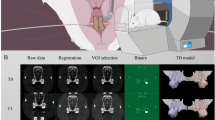Abstract.
For analysis of the initial tooth movement in vivo, an optical measuring apparatus with a resolution of 0,001 degrees for rotation or 0.5 µm for translation respectively has been developed. Its design is described in detail. Because of its high sensitivity it is experimentally feasible to investigate the biomechanical properties of the periodontium under force application and to determine if it makes any difference whether a tooth is rotated mesially or distally out of its neutral position. For that purpose moments with defined time responses are buccally applied to premolars by means of a cardan shaft and the corresponding rotational angle-time characteristics are recorded. As expected, first measurements show sign symmetry for widely spaced teeth. In the case of pronounced anterior crowding, however, asymmetry seems to occur in such a manner that the force system has to overcome a threshold in order to rotate the tooth distally. Additionally, the periodontium may be subject to a sign-dependent rigidity. In all cases, the movement is limited to some degree.
Zusammenfassung.
Zur Analyse der initialen Zahnbewegung ist eine optische Messapparatur entwickelt worden, die eine Auflösung von 0,001° für Rotation bzw. 0,5 µm für Translation besitzt. Ihre Konzipierung wird im Detail beschrieben. Wegen ihrer hohen Empfindlichkeit ist es experimentell möglich, die mechanischen Eigenschaften des Parodonts bei Krafteinwirkung zu untersuchen und der Frage nachzugehen, ob es einen Unterschied macht, wenn ein Zahn aus der Nulllage heraus nach mesial oder distal gekippt bzw. bewegt wird. Dazu werden bukkal über eine Kardanwelle definierte Drehmomente auf Prämolaren übertragen und die entsprechenden Drehwinkel-Zeit-Kurven gemessen. Erste Erprobungen zeigen, dass bei lückig stehenden Zähnen die Vorzeichensymmetrie—wie erwartet—gegeben ist. Bei ausgeprägten Engständen scheint jedoch eine Asymmetrie aufzutreten dergestalt, dass bei Distaldrehung das Kraftsystem einen Schwellenwert überschreiten muss. Außerdem kann das Parodont eine vorzeichenabhängige Steifigkeit besitzen. In allen Fällen gibt es unterschiedliche Limitationen der Bewegung.
Similar content being viewed by others
Author information
Authors and Affiliations
Corresponding author
Rights and permissions
About this article
Cite this article
Ihlow, D., Cronau, M., Kubein-Meesenburg, D. et al. An Experimental Method for In Vivo Analysis of Biomechanical Asymmetries of the Periodontium. J Orofac Orthop 64, 321–329 (2003). https://doi.org/10.1007/s00056-003-0232-8
Received:
Accepted:
Issue Date:
DOI: https://doi.org/10.1007/s00056-003-0232-8




